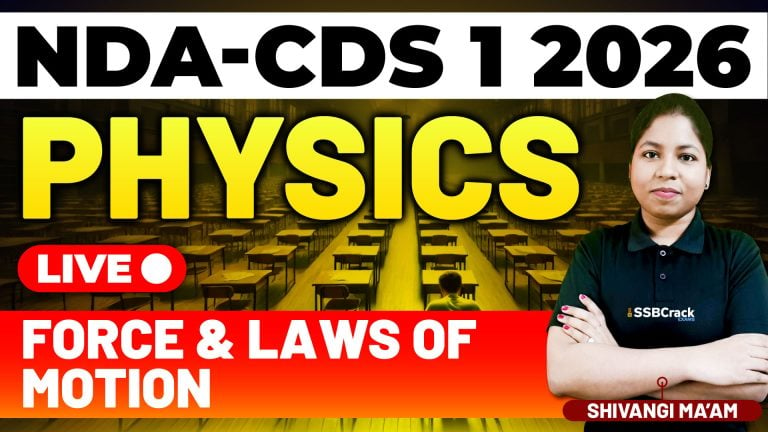A strong foundation in Mathematics is crucial for excelling in the Combined Defence Services (CDS) Exam, and Statistics plays a significant role in the syllabus. To help aspirants solidify their understanding of this subject, a recent class focused on the practice of Multiple-Choice Questions (MCQs) from previous years and expected questions. This hands-on approach provided participants with an opportunity to test their knowledge, identify areas for improvement, and get acquainted with the question patterns.
This blog delves into the key takeaways from the session and outlines strategies to prepare effectively for Statistics in the CDS Exam.
Key Highlights of the Class
The class was designed to provide practical exposure to Statistics-related questions and prepare students to tackle this section confidently. The session included the following focal points:
1. Revisiting Fundamental Concepts
The session began with a brief recap of key topics discussed in earlier classes, such as:
- Data Types: Differentiating between primary and secondary data, and discrete and continuous data.
- Frequency Distributions: Understanding how to organize data into frequency tables.
- Measures of Central Tendency: Focusing on mean, median, and mode, along with their applications.
- Data Representation: Interpreting bar graphs, histograms, pie charts, and frequency polygons.
- Cumulative Frequency Curves (Ogives): Analyzing cumulative data through less than and more than ogives.
This quick review refreshed essential concepts and set the stage for solving MCQs efficiently.
2. Practice with Previous Year Questions
The core of the class involved solving MCQs from previous CDS exams. These questions gave students a clear idea of the type, difficulty level, and format of questions they are likely to encounter. Topics emphasized included:
- Calculating measures of central tendency.
- Interpreting and analyzing graphical data.
- Solving problems related to cumulative frequencies and percentiles.
By working through these questions, students gained insight into commonly tested concepts and how to approach them strategically.
3. Tackling Expected Questions
In addition to previous year questions, the instructor introduced practice problems based on trends and expected patterns. These included slightly more challenging questions designed to enhance problem-solving skills and push students to think critically.
4. Exam-Focused Tips and Tricks
Throughout the class, the instructor shared quick calculation tips, shortcuts, and techniques to save time during the exam. Special attention was given to common pitfalls, such as:
- Misreading graphical data.
- Confusing cumulative frequencies with regular frequency distributions.
- Overcomplicating straightforward problems.
These insights helped participants refine their approach to solving questions more accurately and efficiently.
Strategies for Preparing Statistics for the CDS Exam
To perform well in the Statistics section, it’s essential to combine conceptual understanding with regular practice. Here are some strategies to help you succeed:
1. Build a Strong Foundation
Start by understanding the core concepts of Statistics. Focus on topics like frequency distributions, measures of central tendency, and data visualization. Having clarity on these basics will make it easier to solve related problems during the exam.
2. Focus on Data Representation
- Practice reading and interpreting bar graphs, histograms, pie charts, and cumulative frequency curves.
- Learn how to extract key information quickly and efficiently from graphical data.
3. Solve Previous Year Questions
- Go through past CDS exam papers and solve all Statistics-related questions.
- Analyze the solutions to identify recurring patterns and frequently tested topics.
4. Regularly Practice Expected Questions
Incorporate additional practice problems based on expected trends or slightly higher difficulty levels. These will help you prepare for any surprises in the exam.
5. Develop Speed and Accuracy
- Use calculation shortcuts where applicable to save time.
- Avoid rushing through graphical questions—read the data carefully to minimize errors.
6. Revise Frequently
Dedicate time to revising concepts and formulas regularly. This will ensure that you retain the information and can recall it during the exam.
7. Take Mock Tests
- Attempt full-length mock tests to simulate exam conditions.
- Review your performance and focus on improving weak areas.
8. Seek Guidance
- Join group discussions or study sessions to clarify doubts and exchange problem-solving techniques.
- Consult instructors or online resources for additional support, especially for challenging topics.
Common Mistakes to Avoid
- Neglecting Data Interpretation Skills: Graphical questions often appear simple but require attention to detail. Misinterpreting data can lead to incorrect answers.
- Overlooking the Basics: Skipping fundamental concepts like frequency distributions or the relationship between mean, median, and mode can make advanced questions harder to tackle.
- Relying Solely on Memorization: While formulas are important, understanding when and how to apply them is critical.
- Skipping Practice: Lack of practice reduces familiarity with question types and increases the likelihood of errors during the exam.
Conclusion
The recent class on Statistics was a well-rounded session that combined conceptual reinforcement with practical problem-solving. By focusing on previous year questions and expected problems, students were able to build confidence in tackling this section of the CDS Exam.
To excel in the Statistics portion, aspirants should focus on understanding the fundamentals, practicing regularly, and honing their problem-solving skills. Avoid common pitfalls, and dedicate time to revising and practicing data interpretation questions. With a systematic approach and consistent effort, you can master Statistics and improve your overall performance in the CDS Exam.
Stay disciplined, practice diligently, and success will follow!


















